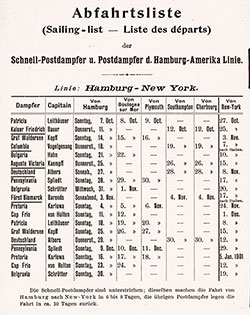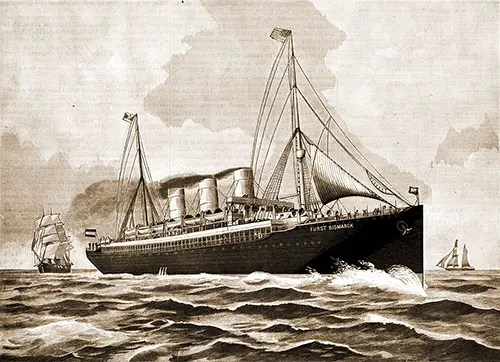SS Fürst Bismarck Archival Collection
Fürst Bismarck (1890) Hamburg-American Line
Built by Akt. Ges. "Vulkan", Stettin, Germany. Tonnage: 8,874. Dimensions: 504' x 57' (520' o.I.). Propulsion: Twin-screw, 19 knots. Triple expansion engines. Masts and Funnels: Two masts and three funnels. Additional Features: Steel hull. Power equipment: 9 boilers; 72 furnaces; 17,000 I.H.P. Passengers: 420 first, 172 second, 700 third. Maiden voyage: Hamburg-Southampton-New York, 1890. Renamed: (a) Don (1904) Russian, (b) Moskva (1906), (c) Gaa (1912) (Austro-Hungarian Navy), (d) San Giusto (1920). Fate: Scrapped in 1924. Running mates: Normannia, Columbia and Auguste Victoria.
Return to Content Links

1900-08-09 SS Fürst Bismarck Passenger List
- Steamship Line: Hamburg Amerika Linie / Hamburg American Line (HAPAG)
- Class of Passengers: Cabin
- Date of Departure: 9 August 1900
- Route: Hamburg to New York via Southampton and Cherbourg
- Commander: Captain H. Barends

1902-01-26 SS Fürst Bismarck Passenger List
- Steamship Line: Hamburg Amerika Linie / Hamburg American Line (HAPAG)
- Class of Passengers: Cabin
- Date of Departure: 26 January 1902
- Route: Naples to New York via Gibraltar
- Commander: Captain H. Barends

1903-08-27 SS Fürst Bismarck Passenger List
- Steamship Line: Hamburg Amerika Linie / Hamburg American Line (HAPAG)
- Class of Passengers: First and Second Cabin
- Date of Departure: 27 August 1903
- Route: Hamburg to New York via Southampton
- Commander: Captain H. Leithäuser
Return to Content Links
Hamburg America Line Cabin Plans of the Twin Screw Steamer SS Fürst Bismarck, c1890. | GGA Image ID # 1ec5b847bb. Dimensions: 17 x 11 7/8 Inches. Click to View Larger Image.
Promenade Deck
Aft: Second Cabin, Smoking Room, Ladies Room, Staterooms 8-13
Midship: First Cabin Smoking Room, State Rooms 3- 7 and 14-18
Forward: Ladies Saloon, Music Room, Staterooms 1,2 and 19, Captains' Quarters
Lower Deck
Second Cabin
Staterooms 160-179
Upper Deck
Aft: Second Cabin Saloon, Staterooms 111-116, Pantry
Midship: Confectionary, Barber, Doctor, Engineers Quarters, Purser, Stateroom 20, 3rd and 4th Officers Quarters, Chief Cook, Butcher, Pantry
Forward: Fri st Cabin Saloon
Main Deck
Aft: Staterooms 117-159, Gents Toilet
Midship: Ladies Toilet, Bath x 2, Bath x 2,
Forward: First Cabin Saloon, Suites 21-110 (Forward and Midship)
Return to Content Links

Hamburg American Line (HAPAG) Sailing Schedule, 7 October 1900 to 19 January 1901
The SS Fürst Bismarck, operated by the Hamburg Amerika Linie / Hamburg American Line (HAPAG), was scheduled for transatlantic voyages between 7 October 1900 to 19 January 1901.

The SS Fürst Bismarck, operated by the Hamburg Amerika Linie / Hamburg American Line (HAPAG), was scheduled for transatlantic voyages between 17 April 1902 to 30 October 1902.

Sailing Schedule, Hamburg - Boulogne-sur-Mer - Plymouth - Southampton - Cherbourg - New York, from 21 June to 11 September 1902. Ships Included the Auguste Victoria, Blücher, Columbia, Fürst Bismarck, Graf Waldersee, Moltke, Palatia, Patricia, Pennsylvania, and Phoenicia. SS Pennsylvania Passenger List, 21 June 1902. | GGA Image ID # 1ee40ad419

Sailing Schedule, Hamburg-Dover-Boulogne-Cherbourg-New York, from 29 July 1905 to 2 December 1905. Ships Included the Amerika, Blücher, Deutschland, Fürst Bismarck, Graf Waldersee, Hamburg, Moltke, Patricia, Pennsylvania, and Pretoria. Steamers "Deutschland, "Moltke, "Bluecher, "and "Hamburg": From New York via Plymouth (London) and Cherbourg (Paris) to Hamburg. Steamers "Patricia, "Pennsylvania, "Graf Waldersee, "Pretoria, "Fürst Bismarck, "Rhaetia ": From New York via Dover (for London or Paris) to Hamburg. SS Graf Waldersee Passenger List, 29 July 1905. | GGA Image ID # 1f06676725

Sailing Schedule, Genoa-Palermo-Naples-New York, from 16 September 1905 to 22 March 1906. Ships Included the Fürst Bismarck, Hamburg, Prinz Adalbert, and Prinz Oskar. SS Hamburg Passenger List, 14 September 1905. | GGA Image ID # 1f58533f5f
Return to Content Links

The Fabulous Interiors of the Great Ocean Liners - 1984
Some 200 superb photographs—in long shots and close-ups—capture exquisite interiors of world's great "floating palaces"—1890s to 1980s: Titanic, Île de France, Queen Elizabeth, United States, Europa, more. Informative captions provide key details.

Leviathan: "The World's Greatest Ship" Volume 1
The first volume takes us from the construction of the VATERLAND to the end of World War One when the VATERLAND, now the U.S.S Leviathan, was used as a troop transport and packed with fabulous photographs and reproductions of newspaper articles.

Passenger Ships of the World - 1963
🎓 “A Global Voyage Through Steamship History for Historians, Genealogists, and Maritime Enthusiasts”
Eugene W. Smith’s Passenger Ships of the World – Past and Present (1963) is a masterfully curated encyclopedic reference that charts the rise, peak, and transformation of ocean-going passenger ships through nearly two centuries. Expanding upon his earlier Trans-Atlantic and Trans-Pacific works, Smith offers a global maritime panorama that includes ships serving the Americas, Africa, Europe, Asia, Australia, and Oceania, as well as Canal routes and California-Hawaii shuttle lines.
🧭 This book is an essential resource for:
- Maritime historians seeking design evolution and fleet data
- Genealogists tracing voyages and shipping lines
- Educators and students studying transoceanic migration and tourism
- Ship modelers, naval architects, and enthusiasts interested in dimensions, tonnage, and speed

The American Line: 1871-1902 (2000)
📚 "Restoring the Stars and Stripes to the North Atlantic"
William H. Flayhart III’s The American Line: 1871–1902 is a powerful narrative chronicling one of the most ambitious yet underappreciated efforts in U.S. maritime history: the rebirth of American transatlantic shipping in the age of steam. For teachers, students, historians, genealogists, and lovers of ocean liner history, this book offers an indispensable resource on how the American Merchant Marine tried to reclaim its former glory after the Civil War devastated the industry.
The book centers around the rise of the American Line, backed by Philadelphia’s business elite and the Pennsylvania Railroad, and its close cousin, the Red Star Line, launched under a foreign flag to circumvent U.S. restrictions. Flayhart’s exhaustive research delivers a sweeping yet accessible account of how these two lines changed the face of transatlantic travel.

Transatlantic and the Great Atlantic Steamships
A stirring narrative of the rapid development of the great transatlantic steamships, from paddle-wheelers to the sleek luxury greyhounds of the modern era -- and the men who designed and ran them.

The New Steamship Fürst Bismarck of the Hamburg-American Line. Scientific American, 30 May 1891. | GGA Image ID # 20ba2899ce
At 11:28 P.M., May 15, the new Hamburg-American steamship Fürst Bismarck arrived at New York on her first trip across the Atlantic, making the passage from Southampton, England, in 6 days, 14 hours, and 7 minutes.
This is not only the fastest time ever made by any vessel sailing from Southampton and the Continent, but, counting the sailing distance from Southampton as sixteen hours farther than from Queenstown, which is usually allowed, it is the fastest maiden trip ever made across the ocean.
The distance sailed was 3,086 miles, and the average speed was 19 1/2 knots. The following were the runs for the successive days: May 9, 426 miles; May 10, 473 miles; May 11, 475miles; May 12, 494 miles; May 13, 481 miles; May 14, 498 miles; May 15, 239 miles.
Prince Bismarck and his family inspected the ship at Hamburg before she sailed and requested the captain to cable him the result of the first trip, the success of which probably exceeded the anticipations of the veteran statesman.
The Fürst Bismarck was built by the Vulcan Shipbuilding Company of Stettin, Germany, and launched on November 29. On her trial trip, she made the speed of 20.7 knots with 91 revolutions of her screws, and her engines indicated 16,400 horsepower. She is 502 1/2 feet long, 57 1/2 feet wide, and 34 1/2 feet deep from the upper deck to the keel plate, being of 8,716 tons register, while all closed rooms of the ship have a capacity of 11,938 tons.
The upper deckhouses are 9 feet high, the promenade deck rooms are 8 feet, and the bridge is 12 feet higher. The tops of the masts are 133 feet above the promenade deck, and the three funnels, each 12 feet in diameter, extend 56 feet above this deck.
The vessel has a solid longitudinal bulkhead from the upper deck to the keel, ultimately dividing the ship lengthwise into two halves, which are non-communicating, each fully equipped with duplicate machinery; each side is also divided into numerous watertight compartments.
The two engines, each with a nominal horsepower of 7,000, are triple expansion, the cylinders being 40, 67, and 106 inches in diameter, and the piston stroke 5 1/2 feet. There are nine double-ended boilers in three separate compartments, each set having independent connections with each set of engines.
There is also one boiler on the upper deck above the water line adapted for connection with the pumps in case of an accident disabling the boilers below. The coal bunkers have a capacity of 2,700 tons.
The main steam pipes are of copper, each being covered with crucible steel 7-18 wire, adding enormously to the strength of the pipes. The shafting, made by Krupp, is of steel and is hollow.
The ship's hull has a double bottom, and the space between the outer and inner shell is divided into chambers to hold water ballast, which can be pumped in or out by automatic pumps.
The vessel has two keels, one on each side, whereby the draught is lessened and rolling somewhat diminished. At the same time, the immersion of the screws is better secured.
The rudder is of great size, and the independent action of the screws also affords the means for readily steering the ship under any circumstances.
The screws are of manganese bronze, 18 feet in diameter each, with three blades and 82 feet pitch. The bosses are of steel, 4 feet 6 inches in diameter. The crew numbers 329.
The vessel is supplied with a complete system of deck and engine room as well as helm and bridge telegraphs, and on the bridge is Alison's motograph, promptly indicating to the bridge officer whether his orders have been understood and carried out. It shows the number of revolutions the engines constantly make and in what direction, whether ahead or astern.
The electric light installation includes four sets of combined engines and dynamos, the latter being compound wound and of Siemens's latest type. A thousand Edison 25-candle power incandescent lamps brilliantly illuminate all parts of the ship.
The furnishing of this splendid ship is of the most luxurious description, the comfort and elegance provided being designed to satisfy the most exacting taste.
The main saloon on the upper deck is 72 feet long and 40 feet wide, well forward of the machinery, and there is another saloon, 50 by 22 feet, on the main deck.
The decorations are of the most sumptuous style, a profusion of rare wood carvings and panel pictures by well-known artists employed to secure the highest effects.
On the voyage, the coal consumption is estimated to have been 262 tons per twenty-four hours. It is claimed that the engines of the new steamer develop a materially higher degree of efficiency than those of the City of Paris or the City of New York, on which the daily coal consumption is about 330 tons.
However this may be, it is inevitable that the performance of the Fürst Bismarck and everything in her appearance, so far as can be judged at present, are well calculated to afford some surprise to English shipbuilders, as she seems to be in every way abundantly capable of taking her place by the side of the finest vessels yet built in English shipyards.
"The New Steamship Fürst Bismarck," in Scientific America: A Weekly Journal of Practical Information, Art, Science, Mechanics, Chemistry, and Manufacturing, New York: Munn & Company, Vol. LXIV, No. 22, 30 May 1891, p. 335.

